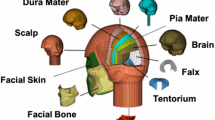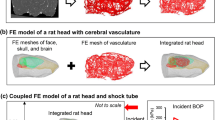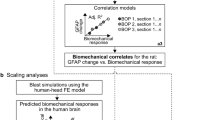Abstract
Computational models of blast-induced traumatic brain injury (bTBI) require a robust definition of the material models of the brain. The mechanical constitutive models of these tissues are difficult to characterize, leading to a wide range of values reported in literature. Therefore, the sensitivity of the intracranial pressure (ICP) and maximum principal strain to variations in the material model of the brain was investigated through a combined computational and experimental approach. A finite element model of a rat was created to simulate a shock wave exposure, guided by the experimental measurements of rats subjected to shock loading conditions corresponding to that of mild traumatic brain injury in a field-validated shock tube. In the numerical model, the properties of the brain were parametrically varied. A comparison of the ICP measured at two locations revealed that experimental and simulated ICP were higher in the cerebellum (p < 0.0001), highlighting the significance of pressure sensor locations within the cranium. The ICP and strain were correlated with the long-term bulk (p < 0.0001) and shear moduli (p < 0.0001), with an 80 MPa effective bulk modulus value matching best with experimental measurements. In bTBI, the solution is sensitive to the brain material model, necessitating robust validation methods.








Similar content being viewed by others
References
Baumgartner, D., M. Lamy, R. Willinger, P. Choquet, C. Goetz, A. Constantinesco, and J. Davidsson. Finite element analysis of traumatic brain injuries mechanisms in the rat. In: IRCOBI Conference, 2009, pp. 97–108.
Bilston, L. E., Z. Liu, and N. Phan-Thien. Linear viscoelastic properties of bovine brain tissue in shear. Biorheology 34(6):377–385, 1997. https://doi.org/10.1016/S0006-355X(98)00022-5.
Cernak, I., Z. Wang, J. Jiang, X. Bian, and J. Savic. Ultrastructural and functional characteristics of blast injury-induced neurotrauma. J. Trauma 50:695–706, 2001.
Chafi, M. S., G. Karami, and M. Ziejewski. Biomechanical assessment of brain dynamic responses due to blast pressure waves. Ann. Biomed. Eng. 38(2):490–504, 2010. https://doi.org/10.1007/s10439-009-9813-z.
Chandra, N., S. Ganpule, N. N. Kleinschmit, R. Feng, A. D. Holmberg, A. Sundaramurthy, V. Selvan, and A. Alai. Evolution of blast wave profiles in simulated air blasts: experiment and computational modeling. Shock Waves 22(5):403–415, 2012. https://doi.org/10.1007/s00193-012-0399-2.
Chandra, N., A. Sundaramurthy, and R. K. Gupta. Validation of laboratory animal and surrogate human models in primary blast injury studies. Mil. Med. 182:105–113, 2017. https://doi.org/10.7205/MILMED-D-16-00144.
Chatelin, S., C. Deck, and R. Willinger. An anisotropic viscous hyperelastic constitutive law for brain material finite-element modeling. J. Biorheol. 27:26–37, 2013. https://doi.org/10.1007/s12573-012-0055-6.
Clemedson, C. J. Shock wave transmission to the central nervous system. Acta Physiol. Scand. 37(2–3):204–214, 1956. https://doi.org/10.1111/j.1748-1716.1956.tb01356.x.
de Rooij, R., and E. Kuhl. Constitutive modeling of brain tissue: current perspectives. Appl. Mech. Rev. 68(1):010801–010801-16, 2016. https://doi.org/10.1115/1.4032436.
Defense and Veterans Brain Injury Center. DoD Numbers for Traumatic Brain Injury. Silver Spring: Defense and Veterans Brain Injury Center, pp. 1–5, 2013.
Elkin, B. S., A. I. Ilankovan, and B. Morrison. Age-dependent regional mechanical properties of the rat hippocampus and cortex. J. Biomech. Eng. 132(1):011010, 2009. https://doi.org/10.1115/1.4000164.
Fallenstein, G., V. Hulce, and J. Melvin. Dynamic mechanical properties of human brain tissue. J. Biomech. 2(3):217–226, 1969. https://doi.org/10.1016/0021-9290(69)90079-7.
Finan, J. D., B. S. Elkin, E. M. Pearson, I. L. Kalbian, and B. Morrison. Viscoelastic properties of the rat brain in the sagittal plane: effects of anatomical structure and age. Ann. Biomed. Eng. 40(1):70–78, 2012. https://doi.org/10.1007/s10439-011-0394-2.
Finan, J. D., S. N. Sundaresh, B. S. Elkin, G. M. McKhann, and B. Morrison. Regional mechanical properties of human brain tissue for computational models of traumatic brain injury. Acta Biomater. 55:333–339, 2017. https://doi.org/10.1016/j.actbio.2017.03.037.
Gadd, C. W., A. M. Nahum, D. C. Schneider, and R. G. Madeira. Tolerance and properties of superficial soft tissues in situ. SAE Techn. Pap. 1970. https://doi.org/10.4271/700910.
Galford, J. E., and J. H. McElhaney. A viscoelastic study of scalp, brain, and dura. J. Biomech. 3(2):211–221, 1970. https://doi.org/10.1016/0021-9290(70)90007-2.
Ganpule, S., N. P. Daphalapurkar, M. P. Cetingul, and K. T. Ramesh. Effect of bulk modulus on deformation of the brain under rotational accelerations. Shock Waves 28(1):127–139, 2018. https://doi.org/10.1007/s00193-017-0791-z.
Gefen, A., N. Gefen, Q. Zhu, R. Raghupathi, and S. S. Margulies. Age-dependent changes in material properties of the brain and braincase of the rat. J. Neurotrauma 20(11):1163–1177, 2003. https://doi.org/10.1089/089771503770802853.
Grujicic, M., W. C. Bell, B. Pandurangan, and P. S. Glomski. Fluid/structure interaction computational investigation of blast-wave mitigation efficacy of the advanced combat helmet. J. Mater. Eng. Perform. 20(6):877–893, 2011. https://doi.org/10.1007/s11665-010-9724-z.
Gupta, R. K., X. G. Tan, M. R. Somayaji, and A. J. Przekwas. Multiscale modelling of blast-induced TBI mechanobiology—from body to neuron to molecule. Def. Life Sci. J. 2(1):3–13, 2017. https://doi.org/10.14429/dlsj.2.10369.
Hua, Y., P. Akula, M. Kelso, and L. Gu. Characterization of closed head impact injury in rat. Biomed Res. Int. 2015. https://doi.org/10.1155/2015/272976.
Jean, A., M. K. Nyein, J. Q. Zheng, D. F. Moore, J. D. Joannopoulos, and R. Radovitzky. An animal-to-human scaling law for blast-induced traumatic brain injury risk assessment. Proc. Natl. Acad. Sci. 111(43):15310–15315, 2014. https://doi.org/10.1073/pnas.1415743111.
Knutsen, A. K., E. Magrath, J. E. McEntee, F. Xing, J. L. Prince, P. V. Bayly, J. A. Butman, and D. L. Pham. Improved measurement of brain deformation during mild head acceleration using a novel tagged MRI sequence. J. Biomech. 47(14):3475–3481, 2014. https://doi.org/10.1016/j.jbiomech.2014.09.010.
Kuriakose, M., M. Skotak, A. Misistia, S. Kahali, A. Sundaramurthy, and N. Chandra. Tailoring the blast exposure conditions in the shock tube for generating pure, primary shock waves: the end plate facilitates elimination of secondary loading of the specimen. PLoS ONE 11(9):e0161597, 2016. https://doi.org/10.1371/journal.pone.0161597.
Mao, H., G. Unnikrishnan, V. Rakesh, and J. Reifman. Untangling the effect of head acceleration on brain responses to blast waves. J. Biomech. Eng. 137(12):124502, 2015. https://doi.org/10.1115/1.4031765.
Moore, D. F., A. Jérusalem, M. Nyein, L. Noels, M. S. Jaffee, and R. A. Radovitzky. Computational biology—modeling of primary blast effects on the central nervous system. Neuroimage 47:T10–T20, 2009. https://doi.org/10.1016/j.neuroimage.2009.02.019.
Moss, W. C., M. J. King, and E. G. Blackman. Skull flexure from blast waves: a mechanism for brain injury with implications for helmet design. Phys. Rev. Lett. 103(10):4–7, 2009. https://doi.org/10.1103/PhysRevLett.103.108702.
Nyein, M. K., A. M. Jason, L. Yu, C. M. Pita, J. D. Joannopoulos, D. F. Moore, and R. A. Radovitzky. In silico investigation of intracranial blast mitigation with relevance to military traumatic brain injury. Proc. Natl. Acad. Sci. 107(48):20703–20708, 2010. https://doi.org/10.1073/pnas.1014786107.
Prange, M. T., D. F. Meaney, and S. S. Margulies. Defining brain mechanical properties: effects of region, direction, and species. Stapp Car Crash J. 44:205–213, 2000.
Przekwas, A., V. C. Chancey, X. G. Tan, Z. J. Chen, P. Wilkerson, A. Zhou, V. Harrand, C. Imielinska, and D. Reeves. Development of physics-based model and experimental validation of helmet performance in blast wave TBI. In: ASME 2009 Summer Bioengineering Conference (2009). https://doi.org/10.1115/sbc2009-206839.
Qian, L., H. Zhao, Y. Guo, Y. Li, M. Zhou, L. Yang, Z. Wang, and Y. Sun. Influence of strain rate on indentation response of porcine brain. J. Mech. Behav. Biomed. Mater. 82:210–217, 2018. https://doi.org/10.1016/j.jmbbm.2018.03.031.
Rodríguez-Millán, M., L. B. Tan, K. M. Tse, H. P. Lee, and M. H. Miguélez. Effect of full helmet systems on human head responses under blast loading. Mater. Des. 117:58–71, 2017. https://doi.org/10.1016/j.matdes.2016.12.081.
Ruan, J. S., T. Khalil, and A. I. King. Human head dynamic response to side impact by finite element modeling. J. Biomech. Eng. 113(3):276–283, 1991. https://doi.org/10.1115/1.2894885.
Sarvghad-Moghaddam, H., A. Rezaei, M. Ziejewski, and G. Karami. CFD modeling of the underwash effect of military helmets as a possible mechanism for blast-induced traumatic brain injury. Comput. Methods Biomech. Biomed. Eng. 20:16–26, 2016. https://doi.org/10.1080/10255842.2016.1193597.
Singh, D., and D. S. Cronin. Efficacy of visor and helmet for blast protection assessed using a computational head model. Shock Waves 27:905–918, 2017. https://doi.org/10.1007/s00193-017-0732-x.
Stalnaker, R. L. Mechanical Properties of the Head. Morgantown: West Virginia University, pp. 1–131, 1969.
Sundaramurthy, A., A. Alai, S. Ganpule, A. Holmberg, E. Plougonven, and N. Chandra. Blast-induced biomechanical loading of the rat: an experimental and anatomically accurate computational blast injury model. J. Neurotrauma 29(13):2352–2364, 2012. https://doi.org/10.1089/neu.2012.2413.
Tan, X. G., A. J. Przekwas, and R. K. Gupta. Computational modeling of blast wave interaction with a human body and assessment of traumatic brain injury. Shock Waves 27:889–904, 2017. https://doi.org/10.1007/s00193-017-0740-x.
Taylor, P. A., and C. C. Ford. Simulation of blast-induced early-time intracranial wave physics leading to traumatic brain injury. J. Biomech. Eng. 131:061007, 2009. https://doi.org/10.1115/1.3118765.
Vappou, J., E. Breton, P. Choquet, R. Willinger, and A. Constantinesco. Assessment of in vivo and post-mortem mechanical behavior of brain tissue using magnetic resonance elastography. J. Biomech. 41(14):2954–2959, 2008. https://doi.org/10.1016/j.jbiomech.2008.07.034.
Ward, J. W., L. H. Montgomery, and S. L. Clark. A mechanism of concussion: a theory. Science 107:349–353, 1948. https://doi.org/10.1126/science.107.2779.349.
Zhang, L., R. Makwana, and S. Sharma. Brain response to primary blast wave using validated finite element models of human head and advanced combat helmet. Front. Neurol. 4:1–12, 2013. https://doi.org/10.3389/fneur.2013.00088.
Zhang, J., N. Yoganandan, F. A. Pintar, T. A. Gennarelli, and B. S. Shender. A finite element study of blast traumatic brain injury. Biomed. Sci. Instrum. 45:119–124, 2009.
Zhu, F., A. Kalra, T. Saif, Z. Yang, K. H. Yang, and A. I. King. Parametric analysis of the biomechanical response of head subjected to the primary blast loading—a data mining approach. Comput. Methods Biomech. Biomed. Engin. 19(10):1053–1059, 2015. https://doi.org/10.1080/10255842.2015.1091887.
Zhu, F., H. Mao, A. Dal Cengio Leonardi, C. Wagner, C. Chou, X. Jin, C. Bir, P. Vandevord, K. H. Yang, and A. I. King. Development of an FE model of the rat head subjected to air shock loading. Stapp Car Crash J. 54:211–225, 2010.
Acknowledgments
This work was supported by Grant No. 14059001 (W81XWH-15-1-0303) under the U.S. Army Medical Research and Materiel Command. Authors acknowledge the assistance of Dr. Saikat Pal with proof reading, Debrina Roy in model development, and Dr. Raj Gupta in theoretical discussions.
Conflict of interest
The authors have no conflicts to disclose.
Author information
Authors and Affiliations
Corresponding author
Additional information
Associate Editor Raj K. Prabhu oversaw the review of this article.
Electronic supplementary material
Below is the link to the electronic supplementary material.
Figure S1
The experimental incident pressure measurements (mean ± one standard deviation, n=4) were compared to the simulated incident pressure measurement at the location at which the Lagrangian part instance was placed (TIFF 157 kb)
Rights and permissions
About this article
Cite this article
Townsend, M.T., Alay, E., Skotak, M. et al. Effect of Tissue Material Properties in Blast Loading: Coupled Experimentation and Finite Element Simulation. Ann Biomed Eng 47, 2019–2032 (2019). https://doi.org/10.1007/s10439-018-02178-w
Received:
Accepted:
Published:
Issue Date:
DOI: https://doi.org/10.1007/s10439-018-02178-w




